Monday, August 7th 2017

Alienware Area 51 Ryzen Threadripper System Benchmarked
LinusTechTips has received an Alienware Area 51, the boutique system which Alienware has developed through its exclusive partnership with AMD for the 16-core, 32-thread Threadripper CPUs.
The system was tested using a proprietary Dell/Alienware motherboard, as well as 32 GB (4x 8 GB) of 2666 MHz DDR4 RAM. Graphics were handled by a Founders Edition GTX 1080 Ti, and storage was etched on a SanDisk A400 256 GB NVME drive (Up to 2050/700 MB/s Sequential Read/Write). The nature of the benchmarked systems, with their myriad of hardware parts, means that the benchmarks are not 100% representative of CPU performance deltas between the tested processors; however, they do put out some interesting numbers. The other HEDT system to be tested was an Intel-based X299 system with a stock Intel Core i9-7900X (10 cores, 20 threads) on an ASUS Prime X299 Deluxe, 4x 8 GB of 3200 MHz DDR4 memory, the same GTX 1080 Ti Founders Edition, and a 512 GB Samsung 950 Pro NVME SSD.With the tested hardware, the Threadripper system delivers 68 maximum and 63 minimum FPS, which puts its slightly ahead of the Ryzen 7 system, and slightly behind, in minimum framerates, compared to the Intel systems (67 minimum for the X299 platform, and 65 for the i7-7700K powered Z270.)3D Mark is a benchmark which doesn't scale linearly according to the number of cores - not even on its CPU test scenario. Instead, this benchmark is optimized for the highest throughput of a given architecture on the maximum number of threads it can actually spawn. This is probably why the Threadripper system delivers slightly better performance than the Ryzen 7 system on the CPU score (though not as much as one might imagine), while the X299 Core i9-7900X steals the show with higher scores across the board and ~2,200 points extra score on the CPU benchmark - despite having six less cores and 12 less threads than the Threadripper system.There's not much of a surprise on the Cinebench benchmarks - this is a benchmark where the Ryzen architecture shines through and through, and it shows here - not even considering the thread advantage of the Threadripper 1950X.The same case can be made for the Blender benchmark, naturally.What do you think of these Threadripper 1950X benchmarks? I'd say these are certainly competent enough to allow users to look at the Ryzen architecture's other strengths.
Check out the LinusTechTips video:
Source:
Linus Tech Tips
The system was tested using a proprietary Dell/Alienware motherboard, as well as 32 GB (4x 8 GB) of 2666 MHz DDR4 RAM. Graphics were handled by a Founders Edition GTX 1080 Ti, and storage was etched on a SanDisk A400 256 GB NVME drive (Up to 2050/700 MB/s Sequential Read/Write). The nature of the benchmarked systems, with their myriad of hardware parts, means that the benchmarks are not 100% representative of CPU performance deltas between the tested processors; however, they do put out some interesting numbers. The other HEDT system to be tested was an Intel-based X299 system with a stock Intel Core i9-7900X (10 cores, 20 threads) on an ASUS Prime X299 Deluxe, 4x 8 GB of 3200 MHz DDR4 memory, the same GTX 1080 Ti Founders Edition, and a 512 GB Samsung 950 Pro NVME SSD.With the tested hardware, the Threadripper system delivers 68 maximum and 63 minimum FPS, which puts its slightly ahead of the Ryzen 7 system, and slightly behind, in minimum framerates, compared to the Intel systems (67 minimum for the X299 platform, and 65 for the i7-7700K powered Z270.)3D Mark is a benchmark which doesn't scale linearly according to the number of cores - not even on its CPU test scenario. Instead, this benchmark is optimized for the highest throughput of a given architecture on the maximum number of threads it can actually spawn. This is probably why the Threadripper system delivers slightly better performance than the Ryzen 7 system on the CPU score (though not as much as one might imagine), while the X299 Core i9-7900X steals the show with higher scores across the board and ~2,200 points extra score on the CPU benchmark - despite having six less cores and 12 less threads than the Threadripper system.There's not much of a surprise on the Cinebench benchmarks - this is a benchmark where the Ryzen architecture shines through and through, and it shows here - not even considering the thread advantage of the Threadripper 1950X.The same case can be made for the Blender benchmark, naturally.What do you think of these Threadripper 1950X benchmarks? I'd say these are certainly competent enough to allow users to look at the Ryzen architecture's other strengths.
Check out the LinusTechTips video:

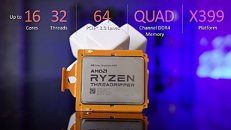
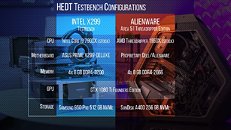

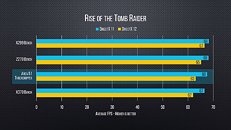
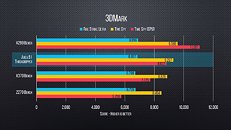
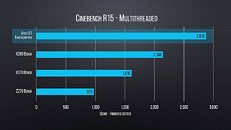

35 Comments on Alienware Area 51 Ryzen Threadripper System Benchmarked
The most reliable DRAM frequency right now is actually 2666MHz. Higher frequencies on the IMC also lower the CPU clocks somewhat (and depending on cooling, drastically). Memory frequency and fabric frequency also don't scale performance much after 2,666MHz in test like Cinebench (or at least Cinebench specifically)
(Except the M11x, that was awesome).
the AIO in question is a rebrand of the Arctic Cooling Liquid Freezer 120 which usually is comparable to most other 240mm due to its thick radiator (49mm vs 26mm for most other asetek 240mm clones).
This points towards that a normal 240mm asetek generic AIO will NOT be sufficient to cool the threadripper platform (atleat the 1950x). The picture might change somewhat if push-pull are used, but i doubt it.
The real problem is more likely the heat-exchanger area might be to small to efficiently draw the heat away from the 4x4 CCX's
Just look at how inaccurate it is.